Introduction to characters;
A successful film opening will establish characters and what their positions may be within the film and will do this very quickly to keep the audience engaged and engrossed in the action. Characters in film openings tend to have their introductions based around their mood, career/job, thoughts, feelings, personality, interests and habits etc. This so that the audience can have an understanding of what is to be expected for the duration of the film.
Bridget Jones’s Diary does this very well for example and within minutes institutes that Englishness and the stereotypical properness with which England can be associated with is a key ingredient for the film. Also, in this opening, the audience can learn merely from Bridget’s appearance that she feels out of place and is in fact single and seeking a partner. The fact that she is overweight and red in the face creates sympathy toward her and means that the film will appeal to women as she is not a promiscuous beautiful woman, meaning she is not a threat to the target audience and is likeable.
Continually, a Romantic Comedy may present two characters, generally a man and a woman living separate lives and feeling as though they want to settle down. More often than not, the directors choose to run these scenes one after the other to show the audience that the characters will have some sort of contact or interaction as the film beings to unfold. This technique is very successful as it makes the audience anticipate who, what, when where and how these characters will meet and under what circumstances.
The way characters relate with other characters is an important aspect in establishing roles. For example, in The Notebook, which is a romantic film, teenagers Allie and Noah are the protagonists and the first time they meet, the audience are made aware of Allie’s heritage and that she is a wealthy girl of high-class, whereas Noah on the other hand is a poor simple boy with a strong sense of adventure. This is shown through the way these characters are dressed and the way they speak. Noah and Allie’s first meeting is at a fairground and Noah asks the beautiful high-class Allie if she would like to dance with him and her response is no thank you, I don’t want to, she then skips off and he gazes after her. This opening scene enforces the character’s backgrounds, values and gives Allie a sense of status, in that she is above Noah due to her wealthy upbringing.
These two elements are so important in making a film successful because the opening is what makes or breaks the film, if an audience is bored by the beginning- which is supposed to be the most exciting and engaging part of the movie- then the film is not going to be a hit. Gripping and seizing audience attention right from the beginning is the most effective way to make a film a success.
CAST;
Who will be cast in a film is so important. Very renowned actors can sometimes be the selling point of films, and some audiences will not be concerned with the genre/theme as long as their favourite actor will be present in the film.
Most people, if they enjoy watching films, will have their personal preferences when it comes to actors or who has produced or even edited the movie and will only want to see certain films because of this.
Another reason why the cast is so important is because very mainstream A-list actors are extremely expensive, and the film company using them will advertise and flaunt the actors they are using as much as possible to make it clear that popular stars have contributed to the making of the film.
For example, in Mr & Mrs Smith, Angelina Jolie and Brad Pitt where the focal point of the film, and their names were shown in the opening of the film as soon as possible. Without them being involved, it is almost certain that the film would not have gained anywhere near as much publicity or viewings and sales would not have sky rocketed and the directors would have probably lost money paying for stunt doubles etc.
In films that are of a much smaller budget and do not use popular mainstream actors, the cast will be shown/mentioned via credits at the very end because who they are is not important as most people will not have heard of them thus meaning the plot in smaller budget films overrides the importance of the actors. This does mean that sometimes, larger budget films can get away with a poor plot so long as big actors are involved.
LOCATION;
The location of the film is of high importance also as the directors do not want to confuse the audience, the location must connect in some form with the characters and plot. If this fails to happen, the audience can feel very out of place. The location must be suitable so that the audience can have an understanding of under what circumstances the action is taking place and they can really get a feel for the atmosphere of the movie.
For example, in the Horror film, ‘The Hills Have Eyes’ the setting is cross-country and very sparse in terms of civilisation. This evokes danger because the audience will already know the film is a horror through advertising and the setting will mean should the characters meet with any monsters, there will be nowhere for them to run to. If this film were set in the hustle and bustle of New York City for example, the same fear and desperation could not be conjured and the film would surely fail.
HISTORICAL PERIOD;
The title sequence of the film will also need to establish in what time period the film is set. For example, the film I-robot is a futuristic science-fiction/action movie set in the future, in a world in which robots are commonly seen and used as servants. Del Spooner (Will Smith) is a Chicago police detective who dislikes the rapid advancement of technology, including robots. Clearly the futuristic element of this film is key in making the film believable- currently robots do not exist, but they could in the future. The film makes sure advanced technology is almost everywhere you look; everything appears to be futuristic from Will Smith’s digital police badge to amazing and intricate appearance of the robots. This is exactly what the audience has paid to see and was one of the reasons why I-Robot was successful. This historical period is important as it more often than not acts as the tying link between the action, characters, sound, costume, props and all the other elements within the making them all fit together and work in perfect sequential rhythm.
MOOD;
The mood of the film is very key in establishing the theme, but is not always immediately noticed as it is not visually present like all the other aspects, this is why the mood is one of the most difficult tasks for the directors to create successfully without being too subtle or too obvious.
For the mood to be logical and accepted, it must appeal to its target audience. For example, the film ‘Girl, interrupted’ which is about a young woman’s experience inside a psychiatric hospital has a very melancholic dark yet inspirational mood and if this film took on the mood of the romantic comedy ‘50 First Dates’ it would remove the serious and sombre mood.
It is important to establish the mood as soon as possible because this is what will keep the audience wanting more.
The fact that ‘Girl, interrupted’ is serious and sombre and about a young woman who is 18 is what reels the target audience in, as this age for woman is notably a time of confusion and rebellion thus meaning the target audience will feel they can empathise with Susanna played by Winona Ryder- the protagonist.
Overall, a title sequence must involve all of these to be very auccessful. Most films do follow the conventions but there are some which are unconventional and continue to be major hits because of this.
What i can learn from this is that our film opening must follow these guidlines to make is as professional and appealing as possible.
Sunday, 28 February 2010
Mood Board
Character Analysis
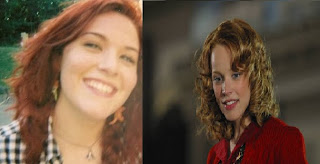
Chloe is genuine and fun loving. She has a kind-hearted nature and would go out of her way to help somebody if they needed it. Features of her personality are that she is always smiling. Chloe is the girlfriend of Cameron.
We chose to look at Allie (Rachel McAdams) from the notebook. Rich, beautiful Allie falls in love with a young man from the wrong side of the tracks, similar to Chloe and Cameron. Allie is very proper and knows right and wrong, she is good-natured and a happy character with positive attributes.
Character Planning
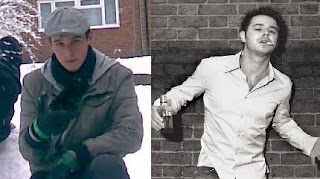
We chose to use Cameron as the cheating male. Cameron speaks with a very strong south london accent, and his interests are football, girls, and drinking. We used Tommy Johnson (Danny Dyer) from football factory as a starting point. Cameron is practically the younger version of Tommy through his attitudes, accent and activities.
In the opening of the film, Cameron cheats on his girlfriend Chloe with Cleo. With Cameron's very blasé nature, he does not think about the consequences his actions could cause were Chloe to discover this.
Storyboards/Planning
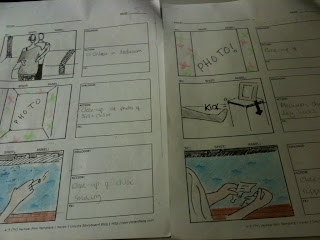
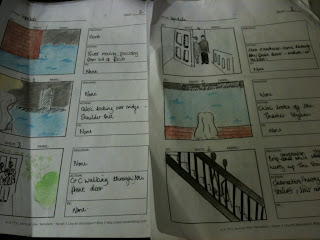
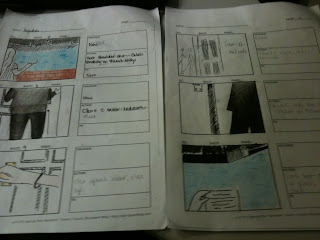
Here we created a storyboard in order to remain organised. We designed a series of illustrations displayed in the sequence that the film would be ordered in. This meant that we knew which direction the film was going in and how we were going to create each scene and with which shots and why.
The first storyboards were created at the Walt Disney Studio during the early 1930s.
As you can see, the principle is exactly the same.
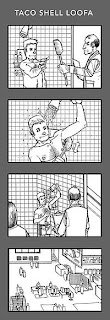
I found using storyboards very useful as it meant we couldn't get sidetracked and could use guidelines were any of our group to become confused about what was meant to be happening during hte filming process
Character Planning
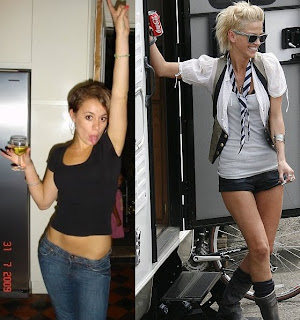
We decided to use Cleo for the role of the promiscuous girl in our film opening as in this photo she fits the stereotype. She achieves this by showing body parts such as her tummy and chest which is suggestive of her personality. The glass of wine she is holding connotes imagery of a party girl and the lifestyle that fits with that. Another reason Cleo's character fits the promiscuous stereotype is her tongue piercing and purposely seductive wide eyed expression.
We got this idea from St. Trinians - an anarchic school for uncontrollable girls. We chose to look at 'Roxy' (Sarah Harding) as she shares similar sterotypical qualities such as minimal clothing and the mindset of knowing she has a certain hold and control over men.
Comparing Film opening sequences (No Country For Old Men, 50 First Dates and Girl, Interrupted)
I looked at No Country for Old Men, which is a sub-genre of the Western and Horror field; Girl Interrupted, which comes under the category of a biography, and 50 First Dates, which is a Romantic Comedy.
I found that No Country for Old Men and girl interrupted did in fact share some qualities.
Firstly I found that the music in both films conveys serious/dramatic themes to the audience. The contrasting element is that No Country for Old Men opens with music that is sinister and serious, whereas although Girl Interrupted opens with a serious tone it also gives the audience the impression that the story which is about to unfold will have a deeper meaning, rather than being just horrific and gory.
The directors have made it very clear to the audience what to expect from the films. They have done this purely through music and tonal qualities; we know Girl, Interrupted will be some sort of life story from the poignancy of the music, and that No Country for Old Men will contain elements of the western genre combined with horror undertones through the menacing pitches.
Completely contrasting both films, the Rom/Com I chose to look at opens with very playful music, consequently suggesting a light-hearted film. Combinations of Hawaiian strumming instruments are used to set the scene and from this the spectators know that the film will not follow a serious attitude- quite the opposite.
The opening to 50 First Dates is very significant in setting the scene- it opens with a long shot of a very romantic, peaceful looking sunset on a sandy beach surrounded by palm trees, and within the first few minutes of the film, sex is the main topic of all conversations among the women that are featured. They are all discussing the same man they slept with, in a comical fashion- Henry Roth (played by Adam Sandler). This accentuates the offhand/joking manner we can expect to see throughout.
The characters in all three films are conventional to their genre; Even though No Country for Old Men is a sub-genre of western and horror, the way in which the characters are represented brings the two together in such a way that we know the film is not going to be one dimensional.
In the opening scene, we see a sheriff- conventional iconography of the ‘Western genre’- who appears to be very relaxed and calm. As the audience, we know he is a sheriff due to clear icons such as his uniform and the office he is in.
Another vital clue that this film is a Western is the Deep South American accent; when we watch a western, this is the accent we can expect to hear.
The horror aspect comes into play when we meet Anton Chigurh (played by Javier Bardem) who is the antagonistic villain. We know this because he is dressed in black from head to toe- The directors have paid close attention to detail here- even his hair and eyebrows are jet black. To me this suggests that there is no goodness or remorse at all. His clothing contrasts that of the sheriff’s as well, which is very light and neutral, a definite connotation of good versus evil.
Girl, Interrupted shares some similarities with No Country For Old Men in that the first thing we see is a close up shot looking through metal bars- giving the effect of being trapped or of feeling claustrophobic- The film is set in a mental institution, which is a place that I would associate with these feelings.
The sky is very dark and gloomy and the whole opening could fit nicely into the horror category. As soon as we meet the characters though, we know this is not right; we see a close up of our protagonist cradling another patient in her arms (this patient is played by Angelina Jolie). This reassures the audience that there is no reason to be afraid in a literal sense. Susanna (played by Winona Ryder)- the protagonist carries an aura of confidence and solidarity.
The actresses in this film are all very renowned and would play a bit role in the selling the film and winning over the public.
Susanna is portrayed as being thoughtful and she is the character we identify with,her mannerisms plainly direct the audience to feel close to her, almost to the extent they feel that they are her, or can feel everything that she feels.
The directors have achieved this through non-diegetic sound; In the opening, Susanna asks rhetorical questions that everyone will have wanted to ask during a time of anxiety or confusion; we admire her for this confidence and strong sense of identity. We are almost in awe of her whole presence.
Moving on to the character representation in 50 First Dates where we meet women who are depicted as being needy and utterly obsessed by men. This is a conventional feature of a Rom/Com as it is not realistic and it means the directors can portray the women in the film as being ‘the same as the rest’ or as though they have no value or personality.
From this character representation, we know that the protagonist (Henry Roth- the topic of conversation for the women) is going to fall for somebody who will have original qualities and won’t be so needy or male-obsessed.
The tones in 50 first dates are light and easy to manage; the film seems to be following the structure of your stereotypical Rom/Com quite religiously. As do all three films I have compared and contrasted.
Personally, I found all films very successful in their efforts to reach their target audience and be box-office hits. A lot of this was achieved through whom they chose to cast in their films- they have all used world-renowned actors/actresses. These would be major selling points for all three films.
I thought that the films were all very conventional and followed the guidelines of their genre consistently- they all featured conventional icons and music to their genre.
For me, the music is what makes a film- for instance, you could watch a horror without the music and you wouldn’t be scared. So during the opening of each film, I felt that the music played a big role in setting the scene and I generally think the directors were successful in their attempts at making their films a triumph in the cinema.
I found that No Country for Old Men and girl interrupted did in fact share some qualities.
Firstly I found that the music in both films conveys serious/dramatic themes to the audience. The contrasting element is that No Country for Old Men opens with music that is sinister and serious, whereas although Girl Interrupted opens with a serious tone it also gives the audience the impression that the story which is about to unfold will have a deeper meaning, rather than being just horrific and gory.
The directors have made it very clear to the audience what to expect from the films. They have done this purely through music and tonal qualities; we know Girl, Interrupted will be some sort of life story from the poignancy of the music, and that No Country for Old Men will contain elements of the western genre combined with horror undertones through the menacing pitches.
Completely contrasting both films, the Rom/Com I chose to look at opens with very playful music, consequently suggesting a light-hearted film. Combinations of Hawaiian strumming instruments are used to set the scene and from this the spectators know that the film will not follow a serious attitude- quite the opposite.
The opening to 50 First Dates is very significant in setting the scene- it opens with a long shot of a very romantic, peaceful looking sunset on a sandy beach surrounded by palm trees, and within the first few minutes of the film, sex is the main topic of all conversations among the women that are featured. They are all discussing the same man they slept with, in a comical fashion- Henry Roth (played by Adam Sandler). This accentuates the offhand/joking manner we can expect to see throughout.
The characters in all three films are conventional to their genre; Even though No Country for Old Men is a sub-genre of western and horror, the way in which the characters are represented brings the two together in such a way that we know the film is not going to be one dimensional.
In the opening scene, we see a sheriff- conventional iconography of the ‘Western genre’- who appears to be very relaxed and calm. As the audience, we know he is a sheriff due to clear icons such as his uniform and the office he is in.
Another vital clue that this film is a Western is the Deep South American accent; when we watch a western, this is the accent we can expect to hear.
The horror aspect comes into play when we meet Anton Chigurh (played by Javier Bardem) who is the antagonistic villain. We know this because he is dressed in black from head to toe- The directors have paid close attention to detail here- even his hair and eyebrows are jet black. To me this suggests that there is no goodness or remorse at all. His clothing contrasts that of the sheriff’s as well, which is very light and neutral, a definite connotation of good versus evil.
Girl, Interrupted shares some similarities with No Country For Old Men in that the first thing we see is a close up shot looking through metal bars- giving the effect of being trapped or of feeling claustrophobic- The film is set in a mental institution, which is a place that I would associate with these feelings.
The sky is very dark and gloomy and the whole opening could fit nicely into the horror category. As soon as we meet the characters though, we know this is not right; we see a close up of our protagonist cradling another patient in her arms (this patient is played by Angelina Jolie). This reassures the audience that there is no reason to be afraid in a literal sense. Susanna (played by Winona Ryder)- the protagonist carries an aura of confidence and solidarity.
The actresses in this film are all very renowned and would play a bit role in the selling the film and winning over the public.
Susanna is portrayed as being thoughtful and she is the character we identify with,her mannerisms plainly direct the audience to feel close to her, almost to the extent they feel that they are her, or can feel everything that she feels.
The directors have achieved this through non-diegetic sound; In the opening, Susanna asks rhetorical questions that everyone will have wanted to ask during a time of anxiety or confusion; we admire her for this confidence and strong sense of identity. We are almost in awe of her whole presence.
Moving on to the character representation in 50 First Dates where we meet women who are depicted as being needy and utterly obsessed by men. This is a conventional feature of a Rom/Com as it is not realistic and it means the directors can portray the women in the film as being ‘the same as the rest’ or as though they have no value or personality.
From this character representation, we know that the protagonist (Henry Roth- the topic of conversation for the women) is going to fall for somebody who will have original qualities and won’t be so needy or male-obsessed.
The tones in 50 first dates are light and easy to manage; the film seems to be following the structure of your stereotypical Rom/Com quite religiously. As do all three films I have compared and contrasted.
Personally, I found all films very successful in their efforts to reach their target audience and be box-office hits. A lot of this was achieved through whom they chose to cast in their films- they have all used world-renowned actors/actresses. These would be major selling points for all three films.
I thought that the films were all very conventional and followed the guidelines of their genre consistently- they all featured conventional icons and music to their genre.
For me, the music is what makes a film- for instance, you could watch a horror without the music and you wouldn’t be scared. So during the opening of each film, I felt that the music played a big role in setting the scene and I generally think the directors were successful in their attempts at making their films a triumph in the cinema.
Analysing and understanding film openings similar to media product.
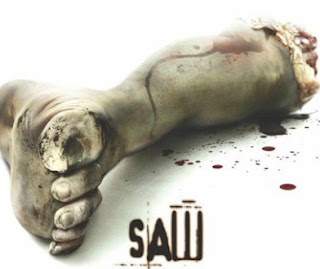
Film opening analysis: SAW 1
From the very beginning- even before the film has started, I can tell that this film is a horror- I know this from the way the credits are being revealed. Titles such as ‘twisted pictures’ being choked by barbed wire for instance, are a dead giveaway to the genre.
The music is made to make you feel on-edge and is very jumpy through crescendo’s which the directors have chosen to use in order to set the scene for the audience and make them feel anxious and nervous.
The film is located in an irrational setting, which immediately distinguishes the film from other genres, such as westerns or romance where there tends to be a definite mood or choice of place which exist in believable worlds.
The audience are made to carry on watching because they want to see how each character dies. This is conventional of a horror as the audience are encouraged to empathise with the ‘monster’ and enjoy the deaths of the innocent victims.
The first clear image we see is a man in a bathtub gasping for breath. Anything the audience can see is murky or unclear which creates a sense of the unknown. We then see a key, which vanishes down the plughole. This that suggests that any means to escape have now vanished.
The audience are then left in darkness. This puts them in the shoes of the victim who is pleading for help and asking ‘is anybody there?’ again reinforcing the director’s idea of the unknown. The character is then met by a voice that is sinister and ominous; this goes with the isolated setting which provokes the audience into an emotional response rather than a moral one, another traditionalist aspect of the horror genre.
When the lights come on, we can see the room that the characters are in is a derelict bathroom of some sort. The iconic features such as the rust on certain objects and how grimy everything appears to be illustrates that what is going to unfold is going to be unpleasant- Somebody who is clearly deranged has set this up and ‘wants to play a game’ –the famous quote from the saw saga.To conclude I think that Saw portrays the horror genre very well because of all the techniques it uses- The sinister setting, the element of fear that is creates and the iconic features and background music is what makes this a good cocktail for a horror film.
Saturday, 27 February 2010
Preliminary task evaluation
To prepare our group for the making of our film opening, we were set a preliminary task. The group consisted of Chloe Gleig, Sid Newman, Lakeisha Sasore and myself.
We had to follow certain guidelines to make sure that when we came to film making, we would have a greater understanding of different shots, editing techniques and sound etc.
The guidelines were;
1. a character opening a door
2. a character crossing a room
3. a character sitting down in a chair opposite another character
Running concurrently to this were;
- dialogue
- match on action shot
- shot reverse shot
- follow the 180 degree rule
The first thing we did as a group was watch some previous AS Preliminary tasks. We did this for inspiration and to give us a rough idea of what we needed to do.
The theme/genre of the preliminary task was open and as a group we decided to go with the Thriller theme. We decided this because we had had a discussion about what genre we wanted our film opening to be and we concluded with a thriller themed opening. It was logical to do a thriller preliminary task as we would have needed to create the right mood and atmosphere along with a setting to prepare us for the real task.
We then decided on a scenario. We chose to do an interview scene, with Lakeisha being the interviewee and myself being the person interviewing her.
Lakeisha has seen a job advertised and has been invited for an interview. Sid and Chloe did most of the filming while Lakeisha and I acted in the task. We agreed that a school classroom would be suitable enough to look like a job interview room, and it would make filming easier as we would not have to go to difficult and specific locations.
To help us navigate our preliminary task, we made a storyboard of all the different shots and camera angles we would be using for the duration of filmmaking. This would act as a guide to avoid any confusion or misunderstandings.
When we first started filming, it was a little difficult as none of our group had used cameras or tripods before. We began by getting to grips with the technical side of filming. We did this by playing around with the different things you could do with the cameras. When we felt comfortable using them, we began filming for our preliminary task.
We used our media classroom to film our job interview. The first shot is filmed from outside the corridor. This became difficult because other students were continually walking to other classrooms etc. We didn’t want to have a silent preliminary task so we had to find the time to film when nobody was around.
We used lots of camera shots and angles relevant to our genre. For example when Lakeisha is approaching the office door, we used a long shot to make the walk appear daunting and ominous. The fact that nobody else was around also added to the thriller element as it created a theme of loneliness.
We then did a close up of Lakeisha opening the door. This was a match on action shot and was successful.
When Lakeisha entered, she crossed the room and sat down in front of Cleo (me). I then asked Lakeisha probing questions in a hostile and strange manner. During the interview, we followed the 180 degree rule. To make it clear that Lakeisha felt uncomfortable, we used medium shots which cut to her lower body constantly fidgeting.
The interview was very short and at the end, I told Lakeisha she had been unsuccessful and I make sure my facial expression is of sheer disdain.
Overall, our preliminary task was successful because we followed and used all of the requirements necessary. The fact that we worked cooperatively as a team helped a lot too because it meant that we could be 100% focused on filming rather than anything else. We felt it was important not to stray away from the criteria as this may have caused complications and confusion, and creativity could be reserved for the film opening.
I thought that for a first attempt, we did very well and we learnt a lot from the experience. It also made me feel confident about the real task because I had more of an idea about what to expect and what it would entail. As we all worked very well together, we decided that we would work together for the Film Opening Task.
We had to follow certain guidelines to make sure that when we came to film making, we would have a greater understanding of different shots, editing techniques and sound etc.
The guidelines were;
1. a character opening a door
2. a character crossing a room
3. a character sitting down in a chair opposite another character
Running concurrently to this were;
- dialogue
- match on action shot
- shot reverse shot
- follow the 180 degree rule
The first thing we did as a group was watch some previous AS Preliminary tasks. We did this for inspiration and to give us a rough idea of what we needed to do.
The theme/genre of the preliminary task was open and as a group we decided to go with the Thriller theme. We decided this because we had had a discussion about what genre we wanted our film opening to be and we concluded with a thriller themed opening. It was logical to do a thriller preliminary task as we would have needed to create the right mood and atmosphere along with a setting to prepare us for the real task.
We then decided on a scenario. We chose to do an interview scene, with Lakeisha being the interviewee and myself being the person interviewing her.
Lakeisha has seen a job advertised and has been invited for an interview. Sid and Chloe did most of the filming while Lakeisha and I acted in the task. We agreed that a school classroom would be suitable enough to look like a job interview room, and it would make filming easier as we would not have to go to difficult and specific locations.
To help us navigate our preliminary task, we made a storyboard of all the different shots and camera angles we would be using for the duration of filmmaking. This would act as a guide to avoid any confusion or misunderstandings.
When we first started filming, it was a little difficult as none of our group had used cameras or tripods before. We began by getting to grips with the technical side of filming. We did this by playing around with the different things you could do with the cameras. When we felt comfortable using them, we began filming for our preliminary task.
We used our media classroom to film our job interview. The first shot is filmed from outside the corridor. This became difficult because other students were continually walking to other classrooms etc. We didn’t want to have a silent preliminary task so we had to find the time to film when nobody was around.
We used lots of camera shots and angles relevant to our genre. For example when Lakeisha is approaching the office door, we used a long shot to make the walk appear daunting and ominous. The fact that nobody else was around also added to the thriller element as it created a theme of loneliness.
We then did a close up of Lakeisha opening the door. This was a match on action shot and was successful.
When Lakeisha entered, she crossed the room and sat down in front of Cleo (me). I then asked Lakeisha probing questions in a hostile and strange manner. During the interview, we followed the 180 degree rule. To make it clear that Lakeisha felt uncomfortable, we used medium shots which cut to her lower body constantly fidgeting.
The interview was very short and at the end, I told Lakeisha she had been unsuccessful and I make sure my facial expression is of sheer disdain.
Overall, our preliminary task was successful because we followed and used all of the requirements necessary. The fact that we worked cooperatively as a team helped a lot too because it meant that we could be 100% focused on filming rather than anything else. We felt it was important not to stray away from the criteria as this may have caused complications and confusion, and creativity could be reserved for the film opening.
I thought that for a first attempt, we did very well and we learnt a lot from the experience. It also made me feel confident about the real task because I had more of an idea about what to expect and what it would entail. As we all worked very well together, we decided that we would work together for the Film Opening Task.
Subscribe to:
Comments (Atom)
